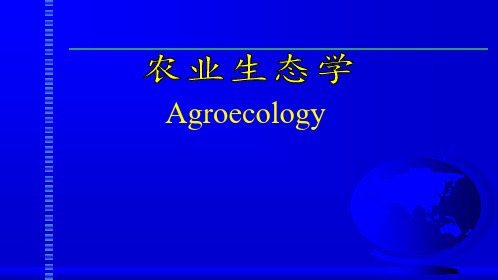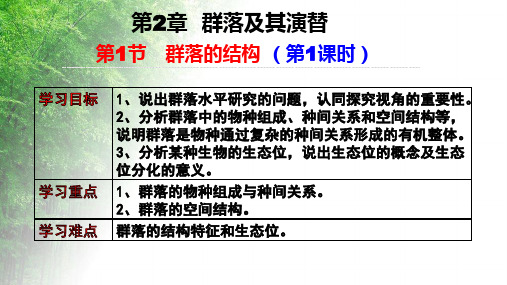1 群落的概念和特征
生物群落的概念与特征

2.群落有一定的相对一致的外貌。 3.在群落中有能大量控制能流及对其它物种和环境强 烈影响的生物优势种现象。 4.随空间和时间变化,群落表现为随环境梯度变化及 随时间演替的现象。 5.群落有一定的营养结构和代谢方式。由不同生物形 成一定的食物网关系和生产、消费、分解特点。
三、生物群落的种类组成及其数量特征
2.群落的数量特征
⑦ 重量(weight):用来衡量种群和群落生物量或现存量的指标。 可分为鲜重和干重来表示。
⑧ 优势度(dominance):用来表示某种生物在群落中作用和地位 大小的指标,是确定优势种的定量指标。
重要值=相对密度+相对频度+相对盖度 重要值越大的种,在群落的结构中就越重要。
第二节 生物群落的结构
2.群落的数量特征
④ 频度(frequency):群落中某一物种在样方内出现的频率。 常按包含该个体的样方数占全部样方数的百分比来计算。
频度=某物种出现的样方数/样方总数×100% ⑤ 高度(height):测量植物体长的一个指标,可取自然高度 或绝对高度。某种植物高度占最高物种高度的百分比称为高度 比,高度比=某一物种的高度/最高物种的高度×100% ⑥ 体积(volume):植物所占空间大小的量度。它在计算林木 蓄积量时非常有用。
➢ 边缘效应(edge-effect):群落交错区种的数目及一
2021高三统考人教生物一轮(经典版)学案:必修3第9单元 第31讲 群落的结构和演替 Word版

姓名,年级:时间:第31讲群落的结构和演替[考纲明细]1。
群落的结构特征(Ⅰ)2。
群落的演替(Ⅰ) 3。
实验:土壤中动物类群丰富度的研究4。
实验:探究水族箱(或鱼缸)中群落的演替课前自主检测判断正误并找到课本原文1.群落的物种组成是区别不同群落的重要特征.(必修 3 P72—正文)(√)2.一种生物以另一种生物作为食物称为捕食,捕食是不同物种之间的关系。
(必修3 P73—图4-10)(√)3.群落的空间结构包括水平结构和垂直结构。
(必修3 P74—正文)(√)4.群落的垂直结构显著提高了群落利用阳光等环境资源的能力。
(必修3 P74—正文)(√)5.土壤中小动物类群丰富度的调查常采用标志重捕法.(必修 3 P75—探究)(×)6.诱虫器主要是利用土壤动物避光、避高温、趋湿的习性采集。
(必修3 P 76-探究)(√)7.随着时间的推移,一个群落被另一个群落代替的过程就叫做演替。
(必修3 P78—正文)(√)8.在沙丘、火山岩、火灾过后的草原、弃耕的农田上进行的演替属于初生演替。
(必修3 P80—正文)(×)9.人类活动往往会使群落演替按照不同于自然演替的速度和方向进行。
(必修3 P81—正文)(√)真题重组判断正误(1)(2017·全国卷Ⅱ)天敌与山鼠之间的种间关系是捕食.(√)(2)(2016·全国卷Ⅲ)若鹰迁入蝉、螳螂和黄雀所在的树林中,捕食黄雀并栖息于林中,则会导致该树林中蝉及其天敌的数量增加。
(×)(3)(2016·全国卷Ⅲ)丰富度是指群落中物种数目的多少。
(√)(4)(2015·全国卷Ⅰ)草本阶段比灌木阶段的群落空间结构复杂。
(×)(5)(2013·全国卷Ⅱ)草原生物群落的空间结构包括垂直结构和水平结构.(√)(6)(2014·全国卷Ⅰ)光裸岩石上的演替为初生演替,从森林被全部砍伐后的地方开始的为次生演替。
高中生物新教材选择性必修二2-1 群落的结构(第1课时

草原中放牧强度加大: 羊草Fra bibliotek糙隐子草
碱蓬
控制放牧强度对于维持草原群落稳定、实现可持续发展非常重要
三、种间关系
1.原始合作 (1)概念: 两种生物共同生活在一起时,双方_都__受__益__,但是分开后,各自也__能__独__立__生__活_; (2)特点:_双__方__都__受__益__,__分__开__也__能__独__立__生__活__________
弱肉强食的残酷世界!
变色龙捕食蟋蟀
射水鱼喷水捕食蟋蟀
(3)数量坐标图和营养关系图
“先增先减”为被捕食者, “后增后减”的为捕食者
特点: 生物A为_被__捕__食__者__,___先__增加___先___减少;一般情况下数量峰值__高___; 生物B为__捕__食__者______,__后___增加__后____减少; 一般情况下数量峰值__低___;
讨论2:资料2说明捕食、种间竞争在群落中是怎样 相互联系的? 海星与藤壶、贻贝、帽贝和石鳖四种动 物存在捕食关系,后四种动物以水中的 浮游生物、腐殖质等为食,彼此存在种 间竞争关系;自然状态下,这五种生物 可以共存,但在人为去除捕食者——海 星之后,而发生变化藤壶、贻贝、帽贝 和石鳖之间是种间竞争,且占优势的物 种随时间推移而发生变化。
甜槠zhū
甜槠花絮
5.常见种 一些物种虽然在群落中比较_常__见___,但对其他物种的_影__响__不__大_____,
它们就_不__占__优__势___; 例如武夷山常绿阔叶林中的狗脊、芒萁;
狗脊
芒萁
6.群落中的物种组成不是固定不变的 羊草为中国内蒙古东部和东北西部天然草场上的重要牧草
随着时间和环境的变化,原来不占优势的物种可能逐渐变得有优势; 原来占优势的物种也可能逐渐失去优势,甚至从群落中消失。
种群和群落知识点总结

种群和群落知识点总结一、种群的概念种群是指在某一地域内所有同一物种的个体的总和,种群的概念是生物学家们在长期实践中总结出来的一个概念。
种群是生态系统中的一个基本单元,它是通过生殖隔离与进化而与其他种群区分开来的一个群体。
种群通常具有以下几个特点:1、同一物种的个体总和。
种群是由同种个体组成的总和,这些个体属于同一物种,可以在某个特定的地理范围内进行交配和繁殖。
2、空间和时间上的联系。
种群的个体之间通常存在一定的空间关系,它们可能生活在同一地区内,如森林、草原、湖泊等特定的生态环境中;同时,种群也有一定的时间联系,可以通过繁殖将其后代代代传承下去。
3、种群数量的动态变化。
种群数量会随着环境变化而产生波动,这可能受到食物、栖息地、气候等因素的影响。
种群数量的动态变化可以直接影响到生态系统的稳定性和生物多样性。
二、群落的概念群落是指在某一地区内由多种不同种群组成的生物社区,它是生态系统中的一个重要组成部分。
群落的概念是生态学家们对不同种群在相同地域内相互作用的总和。
群落通常具有以下几个特点:1、多样性。
群落内通常包含多种不同的物种,它们之间可能是竞争关系、捕食关系、共生关系等各种相互作用。
2、相互依赖。
群落内的不同物种通常是相互依赖、相互作用的。
它们通过食物链、食物网、种间关系等不同的关系方式相互联系在一起。
3、稳定性和动态性。
群落内的种群数量和种类组成是随着时间和环境的变化而发生变化的。
这种动态性使得群落具有一定的适应性和稳定性。
三、种群与群落的关系种群和群落是生态系统中密切相关的两个概念,它们之间存在着紧密的相互关系。
种群和群落之间的关系体现在以下几个方面:1、相互作用关系。
种群和群落之间存在着多种不同的相互作用关系,包括种间相互作用、种内相互作用、种间竞争、捕食关系等。
这些相互作用关系使得种群和群落之间形成了复杂的生态系统。
2、资源利用和能量传递。
种群和群落之间通过资源的利用和能量的传递来维系自身的生存和繁衍。
高三生物一轮复习课件:第29讲 群落及其演替

B.甲、乙主要以浮游植物为食 D.甲、乙的沉浮体现了群落的时间结构
训练4.(2022·山东·高考真题)在一个群落中随机选取大量样方,某种植物出现的样方数占全部样方数的百分比为该
物种的频度,频度分级标准如表所示。在植物种类分布均匀且稳定性较高的生物群落中,各频度级植物物种数在该群
落植物物种总数中的占比呈现一定的规律,如图所示。
荔枝园
种类(种)
个体数量(头)
害虫比例(%)
天敌比例(%)
A
523
103 278
36.67
14.10
回答下列问题: B
568
104 118
40.86
20.40
(1)除了样方法,研究者还利用一些昆虫有____趋__光______性,采用了灯光诱捕法进行取样。
(2)与荔枝园A相比,荔枝园B的节肢动物物种丰富度_____高___________,可能的原因是林下丰富的植被为节肢动物提 供了_食__物__和__栖__息__空__间___,有利于其生存。 (3)与荔枝园B相比,荔枝园A的害虫和天敌的数量______低__________,根据其管理方式分析,主要原因可能是 __荔__枝__园__A__使__用__杀__虫。剂,可降低害虫数量,同时因食物来源少,导致害虫天敌数量也低
荫藏环境,使互花米草因缺乏光照而减少。与本地植物幼苗相比,无瓣
海桑幼苗在荫蔽环境中成活率低,逐渐被本地植物替代,促进了本地植
物群落的恢复。下列说法错误的是(AB)
A.在互花米草相对集中的区域选取样方以估算其在入侵地的种群密度 B.由互花米草占优势转变为本地植物占优势的过程不属于群落演替 C.逐渐被本地植物替代的过程中,无瓣海桑种群的年龄结构为衰退型 D.应用外来植物治理入侵植物的过程中,需警惕外来植物潜在的入侵性
基础生态学-生物第四章第一节生物群落的概念与特征 第二节生物群落的种类组成与数量特征

群落的性质——个体论学派
群落不是自然单位,而是自然界中在空间和时间连续变化系列中的 一个区段
因为在连续变化的环境下的群落组成是逐渐变化的,群落间没有明 显的边界,不同群落类型只能是任意认定的 –群落和物种的关系不是有集体和组织器官关系 –群落的发育过程是物种的更替和种群数量消长过程,和有机体发 育不可比拟 –和有机体不同,群落不可能在不同生境下保持繁殖的一致性 –同一群落类型之间无遗传上的联系
(二)频度 (frequency)
(一)多度、密度、盖度
3、盖度 (coverage) 群落中某一物种的分盖度占所有分盖度之和的百分比,即相 对盖度。某物种的盖度与盖度最大物种的盖度比称为盖度 比。盖度和多度的关系非常密切,通常可出现3种情况:(1)植 物个体数量多,则盖度大,灌林多半如此。(2)有些植物多度 大,盖度并不大,如草本植物。(3)有些植物多度小,但盖度却 大,如乔木树种。
生态学基础 第四章
第二节 生物群落的种类组成与数量特征
教学目标: 1、生物群落种类组成 2、生物群落组成的数量特征 3、群落的物种多样性
一、种类组成
(一)优势种和建群种 优势种 (dominant species): 是指在群落中个体数量多、盖度大,决定群落结构和环境的主要特征, 从而也决定群落组成的那些植物种。 建群种 (constructive species): 是群落的建设者,决定着整个群落的内部构造和特殊环境, 建群种往往是主要层次的优势种。
生态学基础 第四章
第一节 生物群落的概念与特征
教学目标: 1、生物群落的概念 2、生物群落的基本特征
一、群落的概念
对群落 (community)概念的不同认识 – Alexander Humboldt:特定的外貌,对生境因素的综合反应 – E. Warming:一定的种组成的天然群聚 – 俄国学派:有机体的特定组合,有机体之间及其与环境之间相互影响 – W. E. Shelford:具有一致的种类组成且外貌一致的生物聚集体 – E. P. Odum:种类外貌一致、具有一定的营养结构、代谢格局、结构单元、 生命部分
生物高考群落知识点

生物高考群落知识点群落是指生物群体在某一地区内相互依存、相互作用的总体。
在生物高考中,群落是一个重要的知识点。
本文将介绍群落的概念、特点、形成机制以及群落的分类。
一、群落的概念群落是由不同物种组成的共同生活在一定地理范围内的生物群体总体。
这些物种之间存在着相互依存、相互影响的关系。
群落可以包含多种生物,如动物、植物、微生物等。
二、群落的特点1. 多样性:群落中存在多种不同物种,它们之间的种类和数量相对稳定。
2. 依存性:群落中的物种相互依赖,彼此之间形成复杂的生态关系。
3. 稳定性:群落内部的物种组成和结构相对稳定,会经历一系列的变化和演替过程。
4. 互利共生:群落中的不同物种通过相互作用和合作,实现资源的共享和互惠。
三、群落的形成机制群落的形成是由生物群体相互作用和环境条件共同作用的结果。
1. 种间相互作用:包括捕食关系、竞争关系、共生关系等。
通过这些相互作用,物种之间形成了一种平衡状态,共同构成了群落。
2. 环境因素:环境条件对群落的形成也起到重要的影响。
如气候、土壤、水文等因素,会构成不同的生境类型和群落结构。
四、群落的分类根据不同的分类标准,群落可以分为多种类型。
以下是常见的几种分类方法:1. 植被群落:根据主导植物的类型和组合,将群落分为森林群落、草原群落、沙漠群落等。
2. 动物群落:根据生态位和生活习性的相似性,将动物进行分类,如水生群落、陆生群落等。
3. 水生群落:根据所处水域的特点和生物多样性,将群落分为淡水群落、海洋群落等。
结语群落是生物学中一个重要的概念,它涉及到生物之间的相互关系、生态系统的稳定性等方面。
通过了解群落的概念、特点、形成机制以及分类等知识点,我们能够更好地理解生态学的基本原理和生物多样性的重要性。
在生物高考中的相关题目中,对群落的理解和应用是必不可少的。
高三生物一轮复习第二讲群落的结构和演替

第二讲群落的结构和演替考点一群落的结构1.群落的概念与特征(1)概念:同一时间内聚集在一定区域中各种生物种群的集合。
【“集合”不是简单机械聚集,而是通过生物之间相互影响,互相制约而形成的有机整体。
在长期自然选择与进化中形成稳定的,彼此相适应的有机体】种群是群落的基本单位,研究种群是研究群落的基础。
(2)特征:物种组成、丰富度、种间关系、空间结构、群落的演替、优势种、群落的范围和边界等。
2.群落的物种组成(1)意义:是区别不同群落的重要特征。
不同的群落物种的组成不同(2)指标:丰富度,即群落中物种数目的多少。
【一般来说,环境条件越优越,群落发育的时间越长,物种的数目越多,群落的结构也越复杂】(3)丰富度变化情况:从赤道到两极丰富度下降、随海拔高度的增加丰富度减少、随水深度的增加丰富度减少(4)丰富度大小比较:平原<山地草地<林地远离大陆的岛屿<大陆附近的岛屿群落间的过渡地带>非过渡地带拓展:两个或多个群落间过渡地带,即群落交错区,如海陆交界的潮间带、河口湾,森林与草地或农田交界的地带,生物的种类和数量常常比相邻群落中多,这种现象称为边缘效应(5)影响群落物种丰富度的生态因素有多种,如光、温度、水、无机盐等,在某些条件下通常有一种因素起主导作用(6)组成不同群落的优势种不同。
优势种:指对群落影响最大的种群3.群落的种间关系(1)捕食:一种生物以另一种生物(的身体或器官)为食的现象。
注意:同种生物的成体以幼体为食,不是捕食关系,而是种内斗争。
捕食不只是动物之间,动物以草为食,亦是捕食关系。
特点:被捕食者与捕食者之间不同步变化“此消彼长”,相互制约双方的数量,被捕食者不会被(捕食者)淘汰,即不会导致某种生物灭绝。
捕食关系曲线:数量上呈现“先增加者先减少【被捕食者】,后增加者后减少【捕食者】”的不同步性变化(不会导致某种生物灭绝,如图①)。
坐标曲线中捕食者与被捕食者的判定:①从最高点判断,捕食者数量少,被捕食者数量多;②从变化趋势看,先达到波峰的为被捕食者,后达到波峰的为捕食者,即被捕食者变化在先,捕食者变化在后。
- 1、下载文档前请自行甄别文档内容的完整性,平台不提供额外的编辑、内容补充、找答案等附加服务。
- 2、"仅部分预览"的文档,不可在线预览部分如存在完整性等问题,可反馈申请退款(可完整预览的文档不适用该条件!)。
- 3、如文档侵犯您的权益,请联系客服反馈,我们会尽快为您处理(人工客服工作时间:9:00-18:30)。
•长期监测方法(long-term monitoring)
•模型模拟方法(modeling and simulation)
分类、组成和结构
结构:
• • 外貌(physiognormy): 空间结构(spatial structure) 垂直结构 水平结构 空间异质性(spatial heterogeneity) 时间结构 (temporal pattern) 昼夜 季节 营养结构(trophic structure) 食物链(food chain) 食物网(food web) 生态金字塔(ecological pyramid) 营养物种(trophic species):顶位种(top species), 中位种(intermediate species), 基位种(basal species), 孤立种 (isolated species) 同资源种团(guild) 过渡带(ecotone)
• 1916 - Frederick E. Clements. “Plant succession: an analysis of the development of vegetation” –把植物群落定义为有机体, 提出了演替概念,将裸地到演替顶级划 分为群落的几个阶段 • 1926 - Henry Gleason. “The individualistic concept of the plant association” – 指出每 个群落都是独特的,植物群落是环境对 物种的选择而进入这个栖息地的,,这 个观点是群落演替连续体(continuum)的 理论基础。
主要内容
主要内容:
•组成与结构
•性质与功能
•动态 •群落内种间关系 •群落的丰富度、多样性和稳定性 •群落分布格局与环境的关系
基本研究方法
•实验方法(experimentation):实验群落学 (experimental community ecology) •比较方法(comparison):比较群落学 (comparative community ecology)
概念和特征
• 生物群落:在同一时空中存在的所有生物 种群的集合。 • 植物群落(plant community, phytocoenosium,phytocommunity)是 指由一些植物在一定生境条件下所构成的 一个相互影响、互为关联的总体。 • 植被(Vegetation)是指地球表面的一层 活的植物覆盖。
• 1957 - Howard Odum. “Trophic structure and productivity of Silver Springs, Florida” – 首次利 用one of Lindeman„s营养动态的概念,引入了 能量流图解。 concept. - introduced energy flow diagrams of quantitative measures of energy states and fluxes in a natural ecosystem. • 1959 - G. Evelyn Hutchinson. “Homage to Santa Rosalia or why are there so many kinds of animals?” – 提出物种多样性是复杂营养组织结 构和生态位多样性的函数,讨论了多样性与稳 定性和异质性(heterogeneity)的关系.
•被扰乱后的恢复能力(ability of from perturbations of various kinds)
•动态(dynamics)
概念和特征
生物群落也可以从更广的方面来认识,
•物种多样性 •食物网
•能流
•Guilds之间的相互作用
群落学的发展历史
• 19世纪以前 – 强调格局的描述. • 1832 - Hewett C. Watson. “Outlines of the Geographical Distribution of British Plants” – 比较了多种植物的海拔地带性分布. • 1832 - William MacGillivrary. “Remarks on the vegetation of the River Dee” – 讨论 了海拔和地形对高山植物分布的影响.
群落的基本特征
• 具有一定的种类组成和外貌特征 • 植物群落的形成决定于物种的生态幅和环 境的异质性 • 群落是与其环境因子相互作用的综合体 群落=f(土壤+气候+动物+植物区系) • 生物群落是以食物网维系的有机体 • 群落的物种具有不同的重要性 • 群落具有一定的空间界线 • 群落具有时间动态属性
•
•
• •
参考文献
Daubenmire, R. (陈庆诚译). 1982. 植物群落——植物群落生 态学教程. 人民教育出版社.
王伯荪 主编. 植物群落学. 高等教育出版社 曲仲湘 主编. 植物生态学. 高等教育出版社
• 1899 - Henry Chandler Cowles. “The ecological relations of the vegetation on the sand dunes of Lake Michigan” – 研究了 Michigan湖从 1898 至1911年间的演替, 强调了植被的动态特征. • 1913 - Josias Braun-Blanquet. “Remarques sur l„etude des groupements de plantes” – 法瑞学派代表。发展了植物群 落取样的方法,强调区系组成和特征种 的概念。
• 1859 - Charles Darwin. “The Origin of Species...”. –清楚地描述了自然界复杂相互关系, 提出了物种为了生存而发生的生存竞争-即自 然选择. • 1896 - Johannes Eugenius Bulow Warming. "Oecology of plants: an introduction to the study of plant communities" – • 提出了群落学研究的问题1. 为什么每个物种有 自身的栖息地? 2. 物种是怎样聚合形成群落的? 认识到了优势种&亚优势种的作用,火对群落 物种组成&演替的影响以及物候的重要性。他 认为土壤在对群落(植被)的影响中比对气候的 影响更为强烈
(一) 群落的概念和特征
-概述
概念和特征
●生物群落(植物、动物、微生物) biotic community biocoenosis ●群落(表示或大或小的有机体集合) community ●群落生态学 community ecology ●植物群落
plant community,phytocoenosium, phytocommunity
• 1935 - Arthur Tansley. “The use and abuse of vegetational concepts and terms” – 提出 了“生态系统”的概念 ecosystem, 指出 气候、植物&动物都是生态系统的组成 部分,各个组分在功能上紧密相连。强 调群落的演化特征 • 1942 - Raymond Lindeman. “The trophicdynamic aspect of ecology” – 拓展了生态 系统的概念,强调群落内部的能量&养 分循环.
概念和特征
特征:生物群落具有由生物个体间相互 作用确定的各种特征(emergent properties):
•物种丰富度(species richness)
•优势度(dominance) •空间排列(spatial arrangement)
•食物链长度(length of food chain)
•食物网的组织(organization of food web) •对环境变化的抵抗力(resistance to environmental change)
